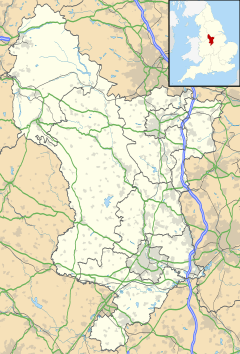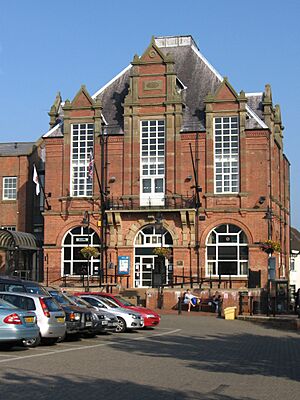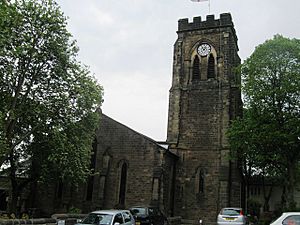Ripley, Derbyshire facts for kids
Quick facts for kids Ripley |
|
|---|---|
|
Clockwise from top: Ripley Town Hall, All Saints' Church, Grosvenor Road, Former railway line-turned greenway passing through the former railway station site and Midland Railway Heritage Railway |
|
| Population | 20,176 (2021 Census) |
| OS grid reference | SK 39746 50502 |
| District |
|
| Shire county | |
| Region | |
| Country | England |
| Sovereign state | United Kingdom |
| Post town | RIPLEY |
| Postcode district | DE5 |
| Dialling code | 01773 |
| Police | Derbyshire |
| Fire | Derbyshire |
| Ambulance | East Midlands |
| EU Parliament | East Midlands |
| UK Parliament | |
Ripley is a busy market town and civil parish in the Amber Valley area of Derbyshire, England. It is located northeast of Derby and is part of a larger urban area that includes nearby towns like Heanor and Ilkeston. In 2021, about 20,176 people lived in Ripley.
Contents
Discovering Ripley's Past
Little is known about when Ripley was first settled. However, it was mentioned in the Domesday Book in 1086. This was a very old survey of England ordered by William the Conqueror.
Early Days and Markets
In 1251, King Henry III gave Ripley permission to hold a weekly market. This market was held every Wednesday. He also allowed an annual fair that lasted for three days. This fair was even older than the famous Nottingham Goose Fair! The market day later changed to Saturdays, with an extra market on Fridays.
Long ago, Ripley was a small village with just a few stone cottages and farms. These buildings were usually found around a village green. Farmers would grind their corn at a mill owned by the Abbot of Darley. Records from 1291 show that Ripley had "two water-mills with fish ponds."
The Rise of Industry in Ripley
Ripley has been an industrial area since the late 1700s. One of the first big companies to use the local minerals was the Butterley Company. This company started in 1790. Its founders, Benjamin Outram and Francis Beresford, were important engineers.
Outram and his partner Jessop were pioneers in the railway industry. They helped design new types of rails. For example, Outram developed the L-shaped flange rail. Jessop designed the cast iron fish belly rail. They also worked on projects like the Little Eaton Gangway.
The Butterley Company was involved in many industries. Over 200 years, they worked with steel, coal mining, quarrying, railways, and brick making. A famous example of their work is the arched roof of St Pancras railway station in London.
More recently, after the year 2000, Butterley helped build the Falkirk Wheel. This is a unique boat-lift for canals. They also built the Spinnaker Tower in Portsmouth Harbour. The engineering part of the company closed in 2010.
Ripley's Mining Heritage
Ripley was also a big coal mining area. The Butterley Company owned many collieries (coal mines) until 1946. This was when the government took over the coal industry. Some of the mines in the area included Ripley colliery and Ormonde. Other pits were located in places like Upper and Lower Hartshay and Waingroves.
How Ripley is Governed
Ripley's Town Hall is a very important building. It was built in 1880 as a market hall. This means it was a place where people could buy and sell goods. The building stands where a much older house once stood.
In 1907, the market hall was changed into the Town Hall. This was done by the Urban District Council, which was the local government at the time. In the 1990s, the building was made much bigger. It became the main office for the Amber Valley Borough Council.
|
People of Ripley
In 2021, Ripley had a population of 20,176 people. Most residents, about 98%, were White British. Other groups like Mixed Race and Asian people made up smaller parts of the population.
When it comes to religion, about 51% of Ripley's residents said they were non-religious. About 48% identified as Christian. Other religions like Islam and Buddhism were also present in smaller numbers. Ripley has slightly more women than men.
Learning in Ripley
Ripley has several schools for different age groups.
Primary Schools in Ripley
- Ripley Junior School
- St Johns C of E Primary School
- Lons Infant School
- Waingroves Primary School
- Codnor Community Primary School
Secondary Schools Near Ripley
- The Ripley Academy
- Swanwick Hall School (about 2 miles north)
- John Flamsteed School (about 2.5 miles south)
Pre-schools and Nurseries
- Ripley Nursery School
- Clowns Day Nursery (two locations)
- Alphabet Childminders
Places of Worship
The Methodist Church on Wood Street is thought to be the oldest church in Ripley that is still active. At one point, there were five Methodist churches in the town. Over time, these congregations joined together. The current church building was rebuilt and reopened in 2009.
After a local event called the Pentrich Rising in 1817, the Vicar of Pentrich Church asked for an Anglican church to be built in Ripley. All Saints' Church, Ripley was built in 1821 by the Butterley Company.
Other places where people worship include the Salvation Army hall. This hall opened in 1911. There is also the Springs of the Living Water, which is in the old St John's Church. The Spiritual Church is on Argyll Road. Marehay Methodist Chapel is in Marehay.
Getting Around Ripley
Ripley has some interesting transport links, both old and new.
Canals and Railways
The Butterley Tunnel runs under the Butterley Company's old site. This tunnel is part of the Cromford Canal. The middle part of the canal is not used anymore. However, a charity is working to reopen it.
Ripley is also home to the Midland Railway – Butterley. This is a special trust that works to save old railway engines and other items. They focus on things related to the Midland Railway.
Ripley once had its own train station, Ripley railway station. It was part of the Midland Railway Ripley Branch. The town was also the end point for the Nottinghamshire and Derbyshire Tramways Company. Later, it was served by the Nottinghamshire and Derbyshire trolleybus system.
News and Entertainment
Ripley has access to local news and entertainment through various channels.
Television and Radio
Local news and TV shows come from BBC East Midlands and ITV Central. These signals are received from the Waltham transmitting station.
Ripley has several local radio stations. These include BBC Radio Derby (104.5 FM) and Smooth East Midlands (101.4 FM). You can also listen to Capital East Midlands (102.8 FM) and Greatest Hits Radio Midlands (106 FM). Amber Sound FM is a community radio station based in Ripley. It broadcasts on 107.2 FM in the Amber Valley area and online.
Local Newspapers
The local newspapers for Ripley are the Ripley & Heanor News and the Derbyshire Times.
Green Spaces and Nature
Ripley offers several parks and natural spots for people to enjoy.
Butterley Reservoir
Butterley Reservoir is located at the bottom of Butterley Hill. It's a great place to watch birds like great crested grebes and coots. There are also platforms for people who like to fish. A footpath lets you walk around and enjoy the views, with the Midland Railway Trust in the background.
Carr Wood
You can enjoy wildlife and a small wooded area at Carr Wood. It's signposted from halfway down Butterley Hill.
Sir Barnes Wallis Recreation Area
At the bottom of Moseley Street, you'll find a recreation area named after Sir Barnes Wallis. This area offers views towards Crich Stand. Crich Stand is a memorial for soldiers from the Sherwood Foresters Regiment. It was first built in 1778 and later dedicated to those who died in World War I and all other conflicts.
The Pit Top
The Pit Top is an open grassy area with some seating and a white arch sculpture. This area is important because it's where the original Ripley Colliery once stood. This coal mine was owned by the Butterley Company and operated from 1863 to 1948.
Crossley Park
Crossley Park is a few acres of grassy land that opened in 1935. It was given to the town by James Crossley in 1901. The park has shrubs and trees around its edges. It also features a children's play area with a paddling pool. There's a paved path for walking and a bandstand that is sometimes used for concerts in the summer.
Ripley's International Connections
Ripley has special connections with two towns in France. It is twinned with Château-Renault and Lons-le-Saunier.
Community Life and Services
Ripley has important community services and groups.
Derbyshire Constabulary Headquarters
The main headquarters for Derbyshire Constabulary, the local police force, is located just outside Ripley at Butterley Hall.
Ripley Community Hospital
Ripley has a community hospital with a minor accident and emergency department. It opened on September 7, 1912. The hospital was built after a miner was injured and couldn't get to Derby for treatment in time. The Ripley Hospital League of Friends is a group that actively raises money for the hospital.
Scouting in Ripley
Ripley has a Scout group that started in 1914. For younger children, there are two Beaver colonies and a Cub pack.
Ripley Music Festival
The Ripley Music Festival has been held in the town every year since 2001.
Famous People from Ripley
Many notable individuals were born or lived in Ripley.
- Gavin Butt (born 1967), an art historian.
- Arthur Octavius Edwards (1876–1960), a civil engineer who built the Grosvenor House Hotel in London.
- Agnes Elizabeth Slack (born 1858), a leading campaigner for temperance (avoiding alcohol).
- John Bamford Slack (1857–1909), a Liberal Member of Parliament and a prominent Methodist.
- Andy Sneap (born 1969), a heavy metal record producer and musician.
- Bombardier Charles Stone (1889–1952), who was awarded the Victoria Cross for bravery.
- Sir James Outram, 1st Baronet (1803–1863), a soldier who fought in the Indian Rebellion of 1857. He was known as the "Bayard of India" and is buried in Westminster Abbey.
- Sir Barnes Wallis (1887–1979), the inventor of the "bouncing bomb". A park in Ripley is named after him. His birthplace has a special blue plaque.
Images for kids
See also
 In Spanish: Ripley (Derbyshire) para niños
In Spanish: Ripley (Derbyshire) para niños










